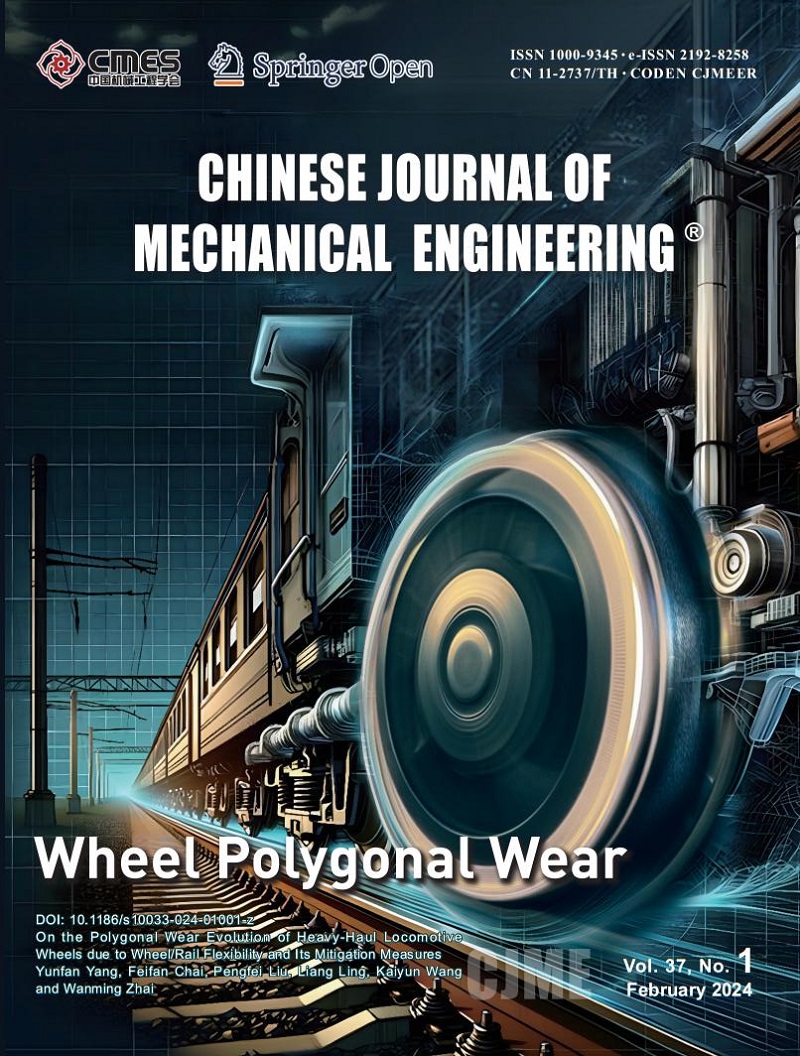1991 Vol.4(4)
Display Mode: |
1991, 5(4).
Abstract:
Due to the need of vision control in robotic welding, the paper presents a mathematical to control welding seam tracking in robotic welding, combining vision signal and robotic kinematics. The control model is not only suitble very well for straight line shaped joints to be welded, but also for broken line ones. At the same time, the accuracy of the mathematical model has been investigated in detail. The result of the simulation welding seam tracking with the model on computer has proved it feasible.
Due to the need of vision control in robotic welding, the paper presents a mathematical to control welding seam tracking in robotic welding, combining vision signal and robotic kinematics. The control model is not only suitble very well for straight line shaped joints to be welded, but also for broken line ones. At the same time, the accuracy of the mathematical model has been investigated in detail. The result of the simulation welding seam tracking with the model on computer has proved it feasible.
1991, 5(4).
Abstract:
This paper presents the results of investigation on the characteristic of forming EHL film by oil-in-water emulsions in point contact condition. The emulsions of diverse proportion and concentration have been prepared by mixing the surfactants and additives with machine oil No.30. The experiment of lubricating properties of the emulsions has been measured on a Optical Interference EHL Tester. The results show that a full EHL film can be formed for the developed emulsions. The ability of forming film is affected by the proportion of emulsifier to base oil. The concentration of base oil and temperature have stronger effect than load on lubricating film. The investigation proved also that the emulsions show similar lubricating properties to the base oil in starved conditions.
This paper presents the results of investigation on the characteristic of forming EHL film by oil-in-water emulsions in point contact condition. The emulsions of diverse proportion and concentration have been prepared by mixing the surfactants and additives with machine oil No.30. The experiment of lubricating properties of the emulsions has been measured on a Optical Interference EHL Tester. The results show that a full EHL film can be formed for the developed emulsions. The ability of forming film is affected by the proportion of emulsifier to base oil. The concentration of base oil and temperature have stronger effect than load on lubricating film. The investigation proved also that the emulsions show similar lubricating properties to the base oil in starved conditions.
1991, 5(4).
Abstract:
The investigation was performed into the characteristics of the void growth at different stress triaxiality levels during plastic deformations using the axisymmetrical smooth and a series of circumferencetially notched tensile specimens of a spheroidized carbon steel. An expression for the least stress triaxiality level, necessary to the lateral growth of voids, was derived from the previous model D[(σm/σ)c]=0.5[1+(2exp1.5εp-1)-1] which shows that, at some plastic strain, the void will start to expand in the transverse direction when a critical stress triaxiality level is exceeded by that in the specimen. The conclusion has been further verified by the experimental observations. Moreover, it is proven that the higher the stress triaxiality level, the lower the aspect ratio of voids during plastic deformations, which causes the lateral coaescence of voids to occur at a lower plastic strain level and leads to the reduction of the material's ductility and toughness.
The investigation was performed into the characteristics of the void growth at different stress triaxiality levels during plastic deformations using the axisymmetrical smooth and a series of circumferencetially notched tensile specimens of a spheroidized carbon steel. An expression for the least stress triaxiality level, necessary to the lateral growth of voids, was derived from the previous model D[(σm/σ)c]=0.5[1+(2exp1.5εp-1)-1] which shows that, at some plastic strain, the void will start to expand in the transverse direction when a critical stress triaxiality level is exceeded by that in the specimen. The conclusion has been further verified by the experimental observations. Moreover, it is proven that the higher the stress triaxiality level, the lower the aspect ratio of voids during plastic deformations, which causes the lateral coaescence of voids to occur at a lower plastic strain level and leads to the reduction of the material's ductility and toughness.
1991, 5(4).
Abstract:
A new theory for determiniing the lubricating state is presented, it is based on a criterion of reliability, which is determined by the distribution function of the particles. The regular statistical distribution function of particle size and its effects on the lubricating state are elucidated. Furthermore the calculation criterion of reliability of the lubricating state is presented according to reliability theory. Finally a comparison between the results obtained from the two methods of that theory is made. Thereby the correctness of the new theory could be confirmed.
A new theory for determiniing the lubricating state is presented, it is based on a criterion of reliability, which is determined by the distribution function of the particles. The regular statistical distribution function of particle size and its effects on the lubricating state are elucidated. Furthermore the calculation criterion of reliability of the lubricating state is presented according to reliability theory. Finally a comparison between the results obtained from the two methods of that theory is made. Thereby the correctness of the new theory could be confirmed.
1991, 5(4).
Abstract:
A method for optimizing the basic structure dimensions of a cam-oscillating roller follower mechanism is presented. The design task is formulated as a two-objective optimization problem subject to multiple constraints. By this method, a cam mechanism with the minimum volume and the least maximum pressure angle can be obtained.
A method for optimizing the basic structure dimensions of a cam-oscillating roller follower mechanism is presented. The design task is formulated as a two-objective optimization problem subject to multiple constraints. By this method, a cam mechanism with the minimum volume and the least maximum pressure angle can be obtained.
1991, 5(4).
Abstract:
This paper proposes a new method of determining the proper blanks for deep drawing parts by means of calculating the converged plastic zone of an infinite sheet metal, applied with deep drawing load by the elasto-plastic FEM. The method mentioned above is suitable for the drawing parts of any contour and anisotropic sheet metal.
This paper proposes a new method of determining the proper blanks for deep drawing parts by means of calculating the converged plastic zone of an infinite sheet metal, applied with deep drawing load by the elasto-plastic FEM. The method mentioned above is suitable for the drawing parts of any contour and anisotropic sheet metal.
1991, 5(4).
Abstract:
Having investigated the relation between coupling degree of quasi-velocity dynamic equation and orthogonality of vector coefficients of quasi-velocities, this paper presents the fundamental principles and general approach as well as the simplified approach choosing quasi-velocities for simplification of dynamic equation. Two examples, and 8 d-o-f spacecraft and a 6 d-o-f robot, are given to demonstrate the advantages of the approaches.
Having investigated the relation between coupling degree of quasi-velocity dynamic equation and orthogonality of vector coefficients of quasi-velocities, this paper presents the fundamental principles and general approach as well as the simplified approach choosing quasi-velocities for simplification of dynamic equation. Two examples, and 8 d-o-f spacecraft and a 6 d-o-f robot, are given to demonstrate the advantages of the approaches.
1991, 5(4).
Abstract:
A synchronous tracker with an advanced cutting technology has been developed, this is the key for high speed thermal cutting on the production line of spiral pipes. This paper presents the design principles, the structural characteristics, the working conditions of the synchronous tracker for cutting, and the cutting properties of the air plasma constricted with water, as well as shows the results of the technological tests and so on.
A synchronous tracker with an advanced cutting technology has been developed, this is the key for high speed thermal cutting on the production line of spiral pipes. This paper presents the design principles, the structural characteristics, the working conditions of the synchronous tracker for cutting, and the cutting properties of the air plasma constricted with water, as well as shows the results of the technological tests and so on.
1991, 5(4).
Abstract:
The principle and mechanism of the brittleness determination of surface treatment layers by rigid ball indentation combined with acoustic emission technique were studied and the application of this method were discussed. It was shown that the sphere of action of main factors influencing surface brittleness behaviour could be synthetically expressed by this method; The surface layer properties of different surface treatment processes could be compared with each other by the method; So it can be used to provide basis for selection of technique processes and parameters, and it has real application value.
The principle and mechanism of the brittleness determination of surface treatment layers by rigid ball indentation combined with acoustic emission technique were studied and the application of this method were discussed. It was shown that the sphere of action of main factors influencing surface brittleness behaviour could be synthetically expressed by this method; The surface layer properties of different surface treatment processes could be compared with each other by the method; So it can be used to provide basis for selection of technique processes and parameters, and it has real application value.
1991, 5(4).
Abstract:
The numberical calculations based on Lagrangian approach for gas-solid two-phase flows in curved ducts are presented in this work. The calculated results indicate that the effect of solid particles on gas velocity is increased with decreasing radius of curvature of the curved duct and the dimensionless particle response time parameter, and with increasing particulate phase mass concentration. The numerical examples show that the predictions based on the present method are in good agreement with the availabe experimental data.
The numberical calculations based on Lagrangian approach for gas-solid two-phase flows in curved ducts are presented in this work. The calculated results indicate that the effect of solid particles on gas velocity is increased with decreasing radius of curvature of the curved duct and the dimensionless particle response time parameter, and with increasing particulate phase mass concentration. The numerical examples show that the predictions based on the present method are in good agreement with the availabe experimental data.




 E-mail Alerts
E-mail Alerts
